
Roanoke City Market Historic District, also known as City Market District, is a national historic district located in the Downtown Roanoke area of Roanoke, Virginia.

Oak Hill is a historic plantation house located near Cumberland, Cumberland County, Virginia. It was built about 1810, and is a two-story, frame dwelling with a center-passage, single-pile floor plan, in the Federal style. It has a one-story rear ell added about 1940. Also on the property are a contributing bank barn, tobacco barn/hay barn, tenant dwelling/granary, and family cemetery. In 1936, the property was acquired by the Resettlement Administration and conveyed by deed to the Department of Conservation and Economic Development in 1954. Since then, it has been rented to employees who are either working at the Cumberland State Forest or for other state agencies.

Trenton, also known as the "Brick House," is a historic plantation home located near Cumberland, Cumberland County, Virginia. It was built about 1829, and is a 2+1⁄2-story, brick dwelling with a center-passage, double-pile floor plan, in the Federal style. It has transitional elements of the Early Classical Revival style. A one-story, shed roofed addition was built about 1960. Also on the property are a contributing stable, brick shed/smokehouse,, grading building, and family cemetery. In 1936, the property was acquired by the Resettlement Administration and conveyed by deed to the Department of Conservation and Economic Development in 1954. Since then, it was used as the State Forest superintendent's home for the Cumberland State Forest until 1990.
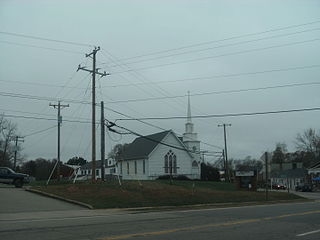
Cumberland Court House Historic District is a national historic district located at Cumberland, Cumberland County, Virginia. The district encompasses 111 contributing buildings, 5 contributing sites, and 8 contributing objects in the county seat of Cumberland County, Virginia. It includes the governmental core of the village and the residential, commercial, educational, and religious resources that have grown up around the courthouse since Cumberland's designation as the county seat in 1777. In addition to the separately listed Cumberland County Courthouse complex, notable buildings include Burleigh Hall, Woodlawn, Center Presbyterian Church (1852), Red Rose Inn, Stewart-Crockett House, All Saints Episcopal Church, Larkin Garrett House (1903), Flippen-Crawley House (1905), Joseph Carpenter House (1903), Masonic Lodge #283 (1903), and Payne Memorial United Methodist Church (1914).

Altavista Downtown Historic District is a national historic district located at Altavista, Campbell County, Virginia. It encompasses 48 contributing buildings in the central business district of Altavista. Notable buildings include the Altavista Municipal Building (1938), U.S. Post Office (1938), Altavista Presbyterian Church (1925), Central Baptist Church (1927), Southern Railway station (1936), Ogden-Henderson Building (1909), First National Bank (1917) by Stanhope Johnson (1882-1973), Leggett's department store (1933), and Vista Theater (1936).

Greenway Historic District is a national historic district located near Boyce, Clarke County, Virginia. It encompasses 432 contributing buildings, 23 contributing sites, and 35 contributing structures. The districts includes the agricultural landscape and architectural resources of an area distinctively rural that contains numerous large antebellum estates. The district contributing buildings are primarily farm and estate residences and their associated outbuildings. Other contributing buildings include three schools, five churches, two mills, a gas station, a restaurant, and a railroad station. The contributing structures are mostly corncribs and the contributing sites are mainly cemeteries and ruins of historic buildings. The district contains ten individual properties and two historic districts already listed on the Virginia Landmarks Register and National Register of Historic Places.
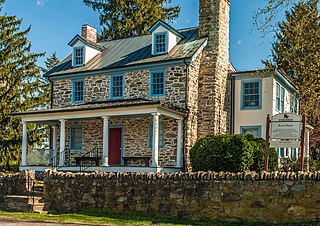
Atoka Historic District is a national historic district located at Atoka, Fauquier County, Virginia. It encompasses 11 contributing buildings in the rural crossroads of Atoka. They include four dwellings and their various outbuildings, two commercial buildings, and a stone spring house. Notable buildings include the Caleb Rector House, the Atoka Store, and the Rector-Deane House (1893).

John Marshall's Leeds Manor Rural Historic District is a national historic district located near Markham, in Fauquier County, northeastern Virginia.
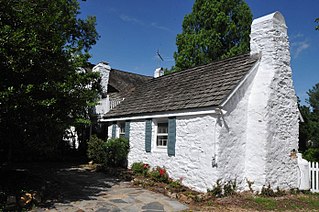
Rectortown Historic District is a national historic district located at Rectortown, Fauquier County, Virginia. It encompasses 76 contributing buildings, 3 contributing sites, and 2 contributing structures in the rural village of Rectortown. The district includes dwellings dating back to the 18th century, churches, a school, an Odd Fellows hall, a post office, multiple commercial buildings, and several cemeteries that illustrate the town's growth and development. Notable buildings include the Maidstone Ordinary, the Rector-Slack Log House, the Ashby House, the Georg Mann House, The Brick Store House, Rector's Warehouse and Station, Denham, Maidstone, Rectortown United Methodist Church (1894), the Jackson-Grant House (1924), Slack's Store (1890), and the Mt. Olive Odd Fellows Lodge (1935).

Woodside is a historic home located near Delaplane, Fauquier County, Virginia. The oldest section was built about 1800, and is located in the rear. It is of hewn log construction, clad with a brick veneer in the mid-20th century and connected to the main house by a hyphen. The main house was built in 1848, and is a two-story, three bay, brick structure in a vernacular Greek Revival style. Also on the property are the contributing log kitchen and a log smokehouse, both built about 1800.

Crooked Run Valley Rural Historic District is a national historic district located near Paris, Fauquier County, Virginia. The district encompasses 386 contributing buildings, 27 contributing sites, and 21 contributing structures. It includes the separately listed Delaplane Historic District and Paris Historic District.

Rocky Mount Historic District is a national historic district located at Rocky Mount, Franklin County, Virginia. It encompasses 211 contributing buildings, 2 contributing sites, 1 contributing site, and 2 contributing objects in the central business district and surround residential areas of Rocky Mount, county seat of Franklin County. It includes residential, commercial, institutional, and governmental buildings dated from the early- to mid-19th through early 20th centuries. Notable buildings include the Rakes Building (1929), N&W Freight Depot, Mount Pleasant (1828–1829), The Taliaffero Building (1827–1828), The Grove (1850), McCall House, Lodge Rooms (Colored), Trinity Episcopal Church, Rocky Mount Presbyterian Church, Baptist Church (Colored), N. Morris Department Store / Bryd Balm Company, Franklin County Courthouse (1909), Franklin County Jail (1938), Franklin County Library (1940), Rocky Mount Municipal Building (1929), and a Lustron house known as the Davis House (1949). Located in the district and separately listed are the Woods-Meade House and the Greer House.

Galax Commercial Historic District is a national historic district located at Galax, Virginia. The district encompasses 67 contributing buildings in the central business district of Galax. A few of the buildings are one-story storefronts, but a majority of the buildings are two-story commercial buildings with either apartments or offices located on the second floor. The majority of the buildings were built in the 1920s. Notable buildings include the old fire station, Colonial Theater (1930), Waugh Department Store (1904), Rex Theater (1938), and Galax Municipal Building (1908).

South Boston Historic District is a national historic district located at South Boston, Halifax County, Virginia. The district includes 594 contributing buildings and 7 contributing structures in the Village of South Boston. It consists of industrial, commercial, and residential building types dating from the mid-19th century to the present. Notable buildings include the C.H. Friend School, New Brick Warehouse, Planters and Merchants Bank, Halifax Cotton Mill, R.J. Reynolds Tobacco Company tobacco prizery, former Liggett-Meyer Tobacco Company tobacco prizery, the Parkinson Block (1899), First Presbyterian Church (1887), First Baptist Church, and Mt. Olive Baptist Church.

Marion Historic District is a national historic district located at Marion, Smyth County, Virginia. The district includes 361 contributing buildings, 2 contributing sites, and 1 contributing object in the central business district and surrounding residential areas of Marion. It includes a variety of residential, commercial, institutional, industrial, and governmental buildings primarily dating from the mid-19th to mid-20th centuries. Notable buildings include the Sheffey Loom House, Odd Fellows Lodge, Look & Lincoln Wagon Factory warehouse, the Beaux-Arts style Marion County Courthouse (1905), Mt. Pleasant Methodist Church, Courtview Building (1890s), Marion High School (1907-1908), Marion Junior College (1912), the Overall Factory, Weiler Building, Bank of Marion (1922), Royal Oak Presbyterian Church (1923), Marion Municipal Building (1935), Marion Post Office (1936), and a Lustron house (1948). Also located in the district are the separately listed Hotel Lincoln, Lincoln Theatre, Marion Male Academy, and Norfolk & Western Railway Depot.

Glenview, also known as Chambliss House, is a historic home located near Stony Creek, Sussex County, Virginia. The original section of the house was built about 1800, and subsequently enlarged and modified in the 1820s. It is a two-story, hip-roofed, five bay dwelling. It has a Georgian central-hall plan with Federal style design influences. Also on the property are a contributing early-19th century frame secondary structure that was likely used as a store and dwelling and the Chambliss family burial ground.
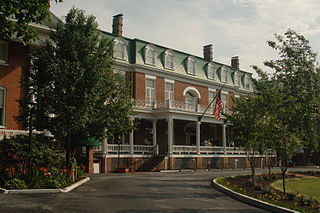
Abingdon Historic District is a national historic district located at Abingdon, Washington County, Virginia. The district encompasses 145 contributing buildings, 2 contributing site, and 13 contributing structures in the town of Abingdon. It includes a variety of residential, commercial, and institutional buildings dating from the late-18th century to the mid-20th century. Notable contributing resources include Sinking Spring Cemetery, William King High School (1913), General Francis Preston House (1832), Martha Washington Inn, Barter Theatre, the Virginia House, Alexander Findlay House (1827), Gabriel Stickley House, Ann Berry House, Washington County Courthouse (1868), Rev. Charles Cummings House, and James Fields House (1857). Located in the district and separately listed are the Abingdon Bank and Dr. William H. Pitts House.
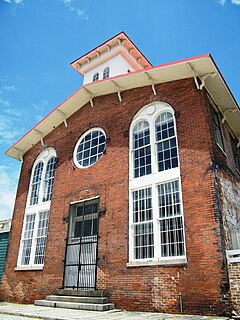
Petersburg Old Town Historic District is a national historic district located at Petersburg, Virginia. The district includes 174 contributing buildings located in the oldest section of Petersburg. It includes a varied collection of late 18th- through 20th-century architecture. Notable buildings include the Strachan-Harrison house, the John F. May house, South Side Railroad Depot, High Street United Methodist Church, Church of Christ (1925), and the Powell Manufacturing Co. Located in the district and separately listed are the Appomattox Iron Works, City Market, Exchange Building, Farmers' Bank and Nathaniel Friend House.

The Winchester Historic District is a national historic district located at Winchester, Virginia. The district encompasses 1,116 contributing buildings in Winchester. The buildings represent a variety of popular architectural styles including Late Victorian and Italianate. They include residential, commercial, governmental, industrial, and institutional buildings dating from the 18th to mid-20th centuries. Notable buildings include the A.M.E Church (1878), Masonic Lodge and Gray and Eddy Building, First Presbyterian Church, Farmers and Merchants Bank (1902), Frederick County Courthouse (1840), Grace Lutheran Church, Friendship Fire Hall (1892), John Kerr School, City Hall (1900), Lewis Jones Knitting Mill (1895), Tidball Residence, William F. Hottle Residence, McGuire Residence, and Robert Long House. Located in the district are the separately listed Thomas J. Jackson Headquarters, Fair Mount, Handley Library, Adam Kurtz House, and Daniel Morgan House.
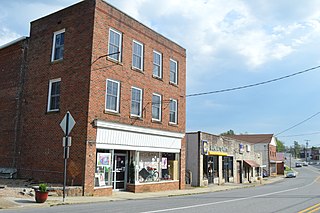
Gretna Commercial Historic District is a national historic district located at Gretna, Pittsylvania County, Virginia. The district encompasses 26 contributing buildings in the central business district of Gretna. The district primarily developed in the early-to-mid-20th century, with buildings dated between about 1881 and 1963. Notable buildings include the Thomas C. and Robert H. Creasy storehouse (1881), Masonic hall (1902), Bank of Elba (1907), Dalton building, W.D. Love and Co. grocery store, Amoco Service Station (1940), former Gretna Fire Station and Town Hall, and Berger Motor Co. (mid-1940s).

























